The evolution of flippers on pinball machines
Flipper bats are what make a pinball machine the game we recognize today. They are the player-controlled mechanisms that distinguish pinball from other skill-based machines, such as bingo machines. In essence, flippers act as an extension of the player's body, controlled by fingertips to manipulate the ball across the playfield.
Flipper bat history
Over time, flipper bats have evolved, both in size and position. In the 1930s, early pinball-style games began to emerge. These were literal 'pin-ball' machines, using metal pins (nails) and a ball. Initially, they were purely mechanical, later incorporating electricity to keep score and add interaction. These machines played similarly to today’s bingo machines: a ball is launched onto a sloped playfield and rolls downward, bouncing around and potentially landing in scoring zones or holes. The goal is to score as much points possible. Once it reaches the bottom, the ball is either out of play or may be launched again.
Flippers debuted in the late 1940s. Gottlieb’s Humpty Dumpty, released in 1947, was the first pinball machine to feature player-controlled flippers. The flipper mechanism was invented by Harry Mabs. At first, flippers were considered a novel addition, somewhat akin to how pop bumpers affect ball movement. The difference: flippers were directly controlled by the player, introducing true skill into the game, beyond simply nudging the cabinet.
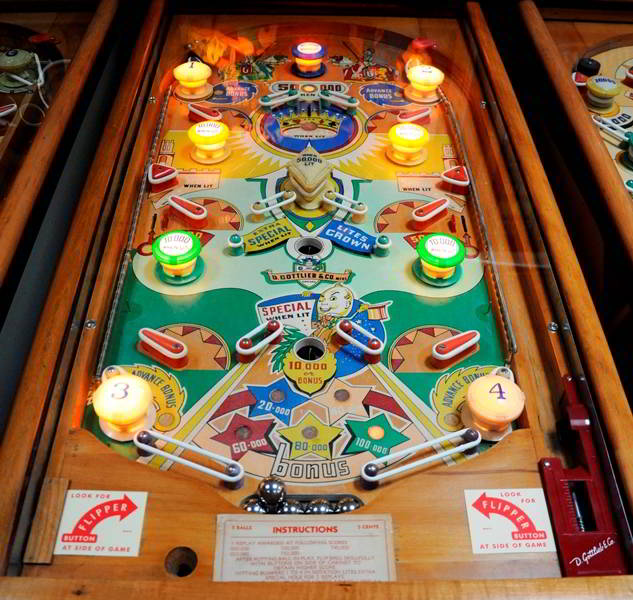
Humpty Dumpty, the first pinball machine with flippers. Notice the instructions for the player that there are buttons to control them
on the sides of the machine.
The flippers themselves were weak and gameplay felt very different from today’s machines. Positioned on the sides of the playfield, their primary goal was to redirect the ball toward scoring holes at the center of the playfield. In general, gameplay still followed a linear path from top to bottom, where maximizing points was the key goal before the ball drained. You could't get the ball back towards the top of the playfield.
In 1948, designer Steve Kordek revolutionized the playfield with Triple Action, relocating the flippers to the bottom. Although the bats pointed outward, opposite of today’s inward-facing layout, the design fundamentally changed how pinball was played. With flippers at the bottom, skilled players could send the ball back to the top, essentially granting additional scoring opportunities during each turn. This innovation allowed games to continue until a ball truly drained off the field, making flippers a pivotal gameplay element.
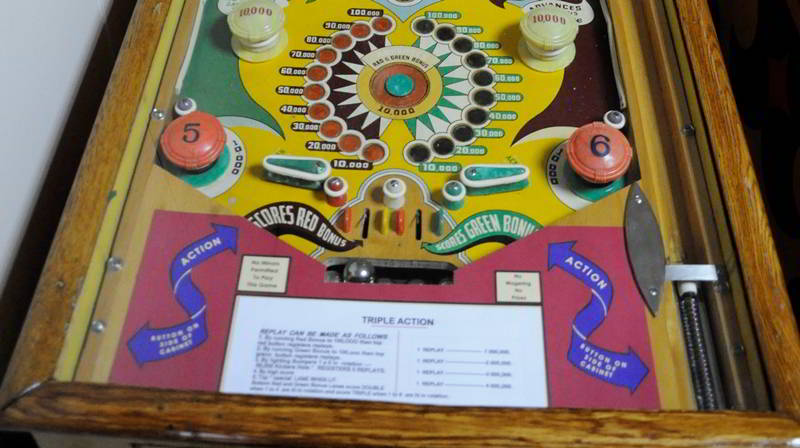
Genco's Triple Action was the first game with bottom-positioned flippers.
By 1950, Wayne Neyens introduced the classic layout on Gottlieb’s Sport Bowler, placing two flippers at the bottom center, facing inward. Throughout the 1950s, designers continued to experiment with flipper positioning. Sometimes placing them high or far apart, while players still relied heavily on nudging and rubber ring interactions to control ball direction. The layout with flippers at the center became more popular by players, and you see pinball designers started to use it more often and experimented less with other positions.
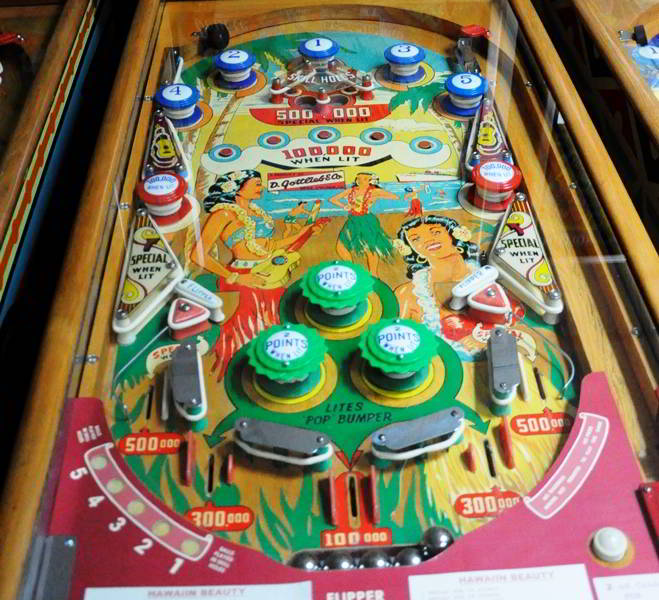
Gottlieb’s Hawaiian Beauty (1954) featured side-mounted flippers halfway up the playfield.
Once the ball reached the lower area, players could only interact with pop bumpers and scoring targets, with no way to send the ball back to the top.
Flipper evolution in the 1960s and 1970s
During the 1960s and 1970s, flipper mechanics evolved dramatically. Electrical coils, now powered by DC instead of AC, made flippers and other mechanisms more powerful. Gameplay became faster-paced and more demanding. Players had to respond quickly and aim more precisely, transforming pinball into a truly skill-based sport.
Playfield designs incorporated lane guides, creating dedicated inlanes and outlanes that funneled the ball toward the flippers for repeated shots. The flippers became central to gameplay and became more incorporated in the playfield, they were no longer isolated elements surrounded by open space.

Gottlieb’s Neptune (1978) showcased an asymmetrical design: on one side a classic slinghot positioned above the flipper,
on the other side a more familiar inlane/outlane configuration. This odd combination reflects ongoing experimentation at the time.
By the late 1970s, manufacturers began transitioning from 2-inch flippers to the longer 3-inch versions. These offered better ball control, increased shot variety, and more power. These 3 inch flipper bats are still in use on modern games. The first machine with 3-inch bats was Williams’ Hayburner 2 in 1968. Other machines in the early 1970s—like Gottlieb’s PlayBall, Williams’ Suspense, and Bally’s Mariner also incorporated them. However, manufacturers didn’t switch immediately. Bally, for instance, continued releasing games with zipper flippers and smaller bats while experimenting with 3-inch designs simultaneously.
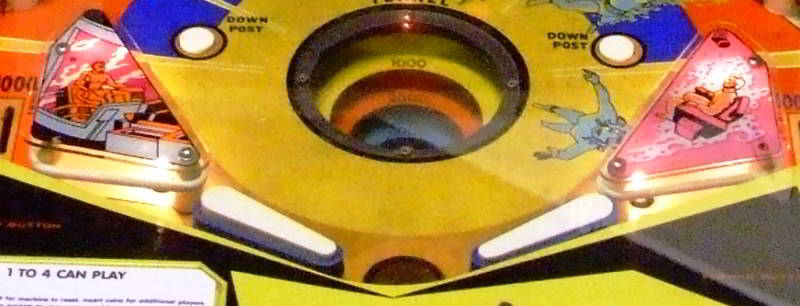
Bally’s Space Time (1971)
was one of the earliest Bally games to feature 3-inch flipper bats.
As with many pinball innovations, player preference and profitability drove change. Successful machines earned money, so manufacturers adopted designs that appealed most to players. By the end of the 1970s, 3-inch flippers became industry standard across all major brands.
It was also in the 1970ies that the 'italian bottom' was requested by players and started to become standard. While some manufacturers kept experimenting with other flipper setups, the italian bottom became standard by the middle of the 1980ies.
Italian bottom
During the same period, the term “Italian bottom” began to gain traction. This layout—consisting of a symmetrical bottom with an outlane, inlane, and flipper on each side, is said to have originated from Italian players. They preferred designs allowing them to trap the ball on a flipper, pause gameplay, gather spectators, and then showcase precise shots to impress friends.
As the story goes, pinball players in Italy in bars liked to show off their skills. They preferred designs allowing them to trap the ball on a flipper, pause gameplay, gather spectators, and then showcase precise shots to impress friends. E.g. when they're just getting a high score or some other kind of achievement. And when possible, they were able to catch the ball again, control it, and show off their trick again.
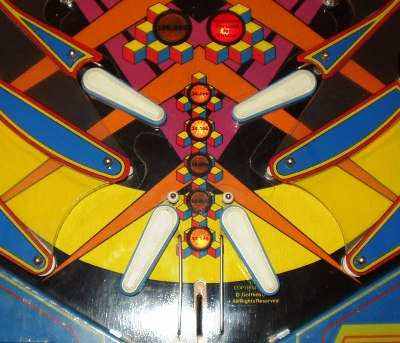 Gottliebs Q-Bert Quest: impossible to try to trap a pinball on the flipper on this machine.
Gottliebs Q-Bert Quest: impossible to try to trap a pinball on the flipper on this machine.
This way of playing pinball wasn't possible on all pinball machines. Some layouts didn’t allow trapping due to slingshot and flipper spacing. So operators got this request from players (and noticed games without an italian bottom earned much less), and let the manufacturers know about this. Related to this story, the term italian bottom is now used for games that have the standard layout as we know it now. On each side an outlane, inlane and the flippers in central position. No special layouts anymore of multiple outlanes, off center flippers or other experiments. Pinball designers noticed this was a layout that players preferred and they didn't try to invent something new anymore.
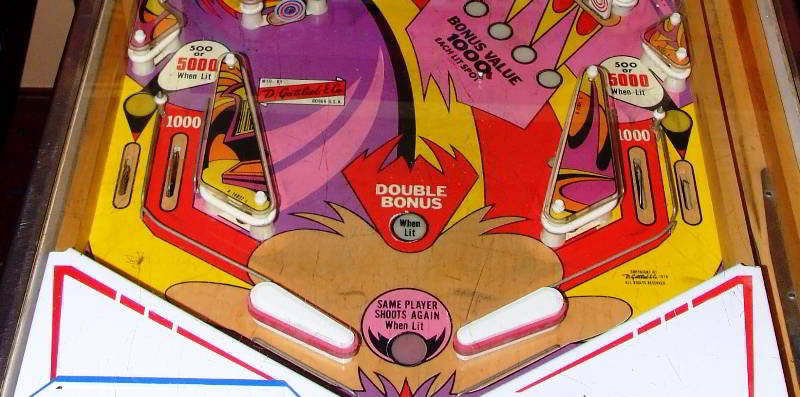
Gottlieb’s Target Alpha (1976) features a classic Italian bottom layout.
Zipper flippers
Zipper flippers were an innovative design used by Bally between 1966 and 1973. Found in titles like Fireball and 4 Million BC. These flipper bats could close their gap while in the resting position. If the player activates certain bumpers, the flippers move toward each other, preventing the ball from draining between them, while still allowing active control. The flippers still activate and kick the ball upwards when activated. Hitting another mushroom target would reopen them, the flippers move back to their initial position.
 Bally Fireball (1972) with zipper flippers open.
Bally Fireball (1972) with zipper flippers open.
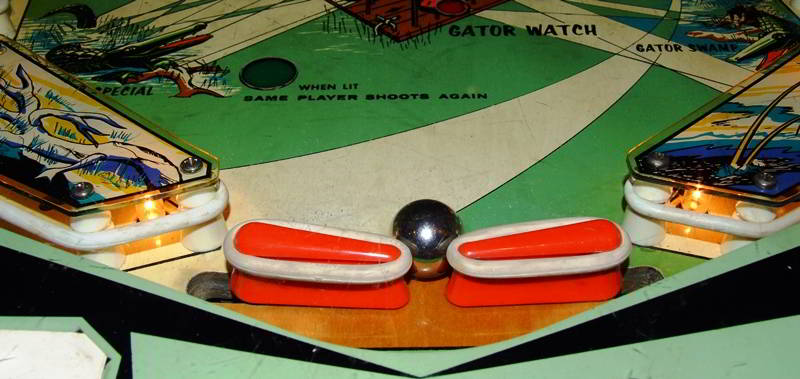 Bally Gator (1969) with zipper flippers closed.
Bally Gator (1969) with zipper flippers closed.
Lightning flippers
Lightning flippers were introduced on select Bally/Williams WPC machines between 1992 and 1993. They are slightly shorter, about 1/8-inch, than standard 3-inch bats, with a lightning bolt graphic that gives them their name.
A large French importer requested them to reduce game duration, since skilled players could extend play for long periods. Shorter flippers increased the drain gap and made certain shots more challenging. Operators thought they would earn again more if game duration was shortened. Games featuring lightning flippers include Fish Tales, Doctor Who, Bram Stoker’s Dracula, and Popeye.
Player opinions vary. Some preserve the original setup for authenticity, while others replace them with standard bats for improved gameplay. In my own collection, I prioritize gameplay quality and designer intent, so I prefer standard flippers, even if that’s not how the game originally shipped.
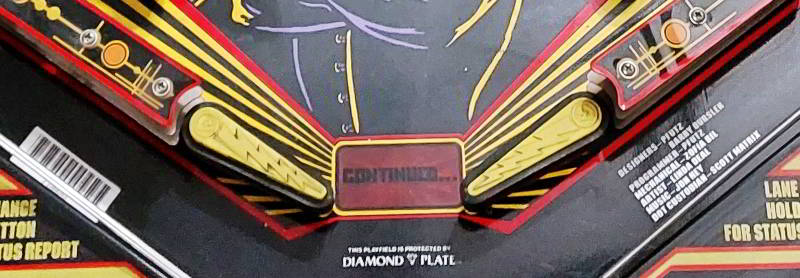 Bally Doctor Who (1992) with lightning flipper bats.
Bally Doctor Who (1992) with lightning flipper bats.
Banana flippers
Bally experimented with curved, 'banana' flippers on titles like Time Warp and Disco Fever. These non-standard curved bats created unpredictable ball physics and were generally unpopular among players.
Ribbed flippers
At the end of the 1980ies, Bally / Midway used their own style of flipper bat. It was also 3 inch, but ribbed on top.

Bally Atlantis (1989) with ribbed flipper bats.
Boney flippers
Bally’s Scared Stiff (1997) featured a unique design with 3D-molded flipper bats shaped like bones. This aesthetic matched the game’s extensive custom sculpted parts, including slingshots and lane guides.
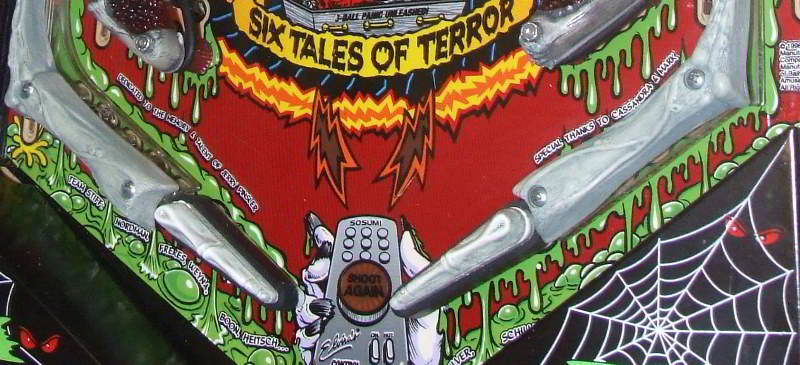
Bally Scared Stiff (1997) with 3D boney flipper bats.
If you're looking for pinball parts, then check out Pinballshop.nl (affiliate link).
